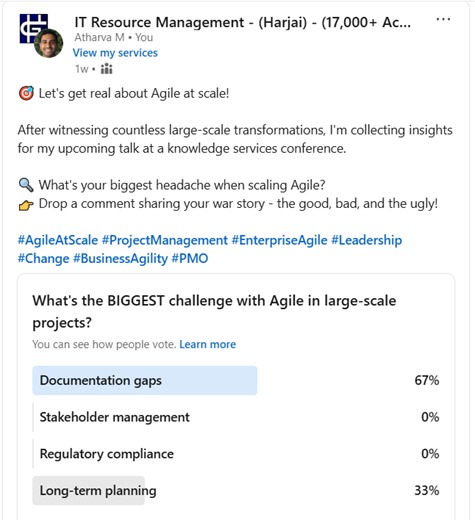
Agile has revolutionized the way organizations approach project management. With its emphasis on flexibility, collaboration, and iterative delivery, Agile has become the go-to methodology for many teams. However, while Agile works well in small teams, scaling it across large enterprises presents significant challenges.
To understand these challenges better, we conducted a poll asking professionals

“What’s the biggest challenge with Agile in large-scale projects?”
The results were quite revealing:
📌67% of respondents pointed to documentation gaps as the biggest hurdle
📌 33% struggled with long-term planning
📌 Surprisingly, stakeholder management and regulatory compliance received no votes
These insights highlight a crucial reality—while Agile is designed for adaptability and speed, large-scale implementations often encounter structural and operational roadblocks. In this blog, we’ll explore why documentation gaps and long-term planning are major pain points and how organizations can overcome these hurdles to truly unlock Agile’s potential at scale.
🚧 1. The Documentation Dilemma – Agile’s Greatest Irony
Agile principles emphasize “working software over comprehensive documentation,” which works well in small teams where communication is fluid, and knowledge is easily shared. However, when Agile is applied at scale across multiple teams, geographies, and departments, the lack of structured documentation quickly becomes a bottleneck.
Why Do Documentation Gaps Hurt Large-Scale Agile?
1️Knowledge Loss: Without proper documentation, critical project knowledge resides in individuals’ minds, leading to challenges in knowledge transfer when employees leave or teams change.
2️nboarding Challenges: New team members struggle to get up to speed without well-documented processes, leading to productivity delays.
3️Regulatory and Compliance Risks: Many industries, especially finance, healthcare, and government sectors, require rigorous documentation to meet compliance standards. A lack of proper documentation can lead to legal and operational risks.
4️Inter-Team Misalignment: Large organizations often have multiple teams working on interconnected projects. Without proper documentation, teams face miscommunication, duplication of effort, and delivery delays.
How Can Organizations Fix the Documentation Gap?
- Implement “Just Enough” Documentation: Instead of exhaustive documents, use lightweight, dynamic documentation that evolves with the project.
- Use Collaborative Documentation Tools: Platforms like Confluence, Notion, Miro, and Wikis enable real-time documentation updates without excessive overhead.
- Automate Documentation Where Possible: Tools like Jira, Azure DevOps, and GitHub Wiki can generate automated project documentation, reducing manual effort.
- Standardize Key Documentation Areas: Identify essential documents such as backlog grooming notes, sprint retrospectives, architectural decisions, and compliance reports, and ensure they are regularly updated.
The goal is to strike a balance between agility and necessary documentation—keeping the process lightweight yet structured enough to support large-scale execution.
📅 2. The Long-Term Planning Puzzle – Agile’s Biggest Trade-off
Agile thrives on adaptability, but enterprises need a long-term vision to allocate budgets, resources, and strategic goals effectively. When Agile is scaled, long-term planning often becomes a major challenge.
Why is Long-Term Planning So Difficult in Large-Scale Agile?
1.Short-Term Iterations vs. Strategic Vision: Agile teams focus on short sprints (2-4 weeks), making it difficult to align their work with long-term business goals.
2. Budget Forecasting Challenges: Traditional budgeting relies on fixed scopes, while Agile embraces changing requirements, creating conflicts in financial planning.
3. Cross-Team Dependencies: In large-scale Agile, multiple teams work on different parts of a system. Without proper long-term planning, dependencies can cause bottlenecks.
4. Leadership’s Demand for Predictability: Senior executives and stakeholders expect clear roadmaps, delivery estimates, and ROI predictions—something Agile alone doesn’t always provide.
How Can Organizations Balance Agile and Long-Term Planning?
- Adopt Scaled Agile Frameworks (SAFe, LeSS, Disciplined Agile): These frameworks integrate long-term planning while preserving Agile’s iterative approach.
- Use Agile Roadmaps: Agile roadmaps provide a high-level vision that aligns sprint goals with long-term business objectives.
- Implement PI (Program Increment) Planning: Agile Release Trains (ARTs) in SAFe allow teams to plan 8-12 weeks ahead while maintaining agility.
- Leverage Agile Portfolio Management: Tools like Jira Align, Planview, and Aha! help enterprises manage Agile execution while keeping leadership aligned with long-term strategy.
- Emphasize OKRs (Objectives and Key Results): Aligning Agile teams with company-wide OKRs ensures that daily Agile efforts contribute to long-term success.
The key takeaway? Agility and strategic planning are not mutually exclusive. Enterprises must blend Agile execution with structured long-term planning to achieve both speed and scalability.
Final Thoughts – Agile Needs Structure to Scale
Agile isn’t a magic bullet. While it enhances adaptability and responsiveness, large-scale implementation requires structured processes to prevent chaos. Our poll clearly highlighted two major challenges—documentation gaps and long-term planning—which, if not addressed, can derail Agile transformations.
✅ Agile documentation should be lightweight but structured enough to support scale.
✅ Long-term planning must align with Agile execution while ensuring strategic direction.
✅ Enterprises must blend Agile principles with frameworks that support scale.
By addressing these challenges, organizations can unlock Agile’s full potential without sacrificing structure, compliance, or business alignment.
What’s Your Experience with Scaling Agile?
What challenges have you faced while implementing Agile in large-scale projects? Do you agree that documentation and long-term planning are major hurdles? Drop a comment and share your insights!
Contact Us: info@whizible.com | +91 855 498 3315
Address: Mrugank, Level 3, Kothrud, Pune, Maharashtra, 411038


